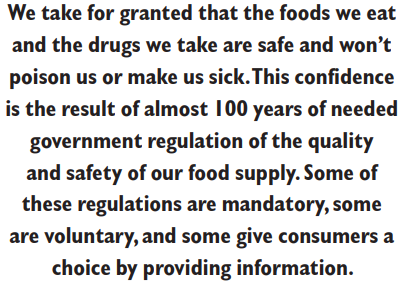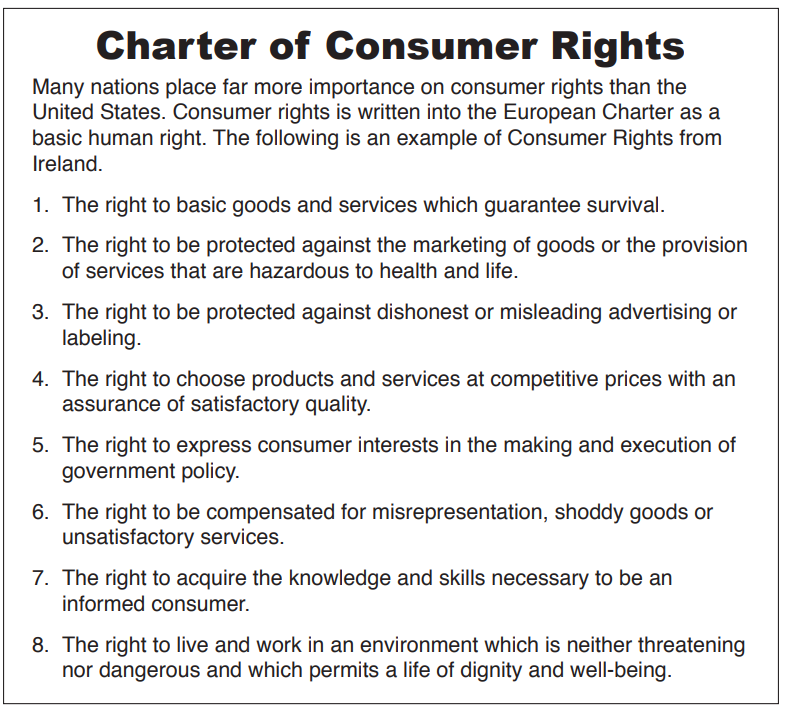The United States Food and Drug Administration (FDA) is responsible for assuring that foods sold in the United States are safe, wholesome and properly labeled. This applies to foods produced domestically, as well as foods from foreign countries. The Federal Food, Drug, and Cosmetic Act (FD&C Act) and the Fair Packaging and Labeling Act are the Federal laws governing food products under FDA’s jurisdiction.
The Nutrition Labeling and Education Act of 1990, which amended the FD&C Act requires most foods to bear nutrition labeling and requires food labels that bear nutrient content claims and certain health messages to comply with specific requirements.
Evolving law
The U.S. passed its first pure food and drug act in 1906. Since then the law has evolved to deal with other threats to the public safety and health and to give consumers more information about the products they buy.
Following are some of the major laws dealing with food, drugs, and consumer rights.
1906 - The original Pure Food and Drugs Act is passed by Congress on June 30 and signed by President Theodore Roosevelt. It prohibits interstate commerce in misbranded and adulterated foods, drinks and drugs. The Meat Inspection Act is passed the same day. Shocking disclosures of insanitary conditions in meat-packing plants, the use of poisonous preservatives and dyes in foods, and cure-all claims for worthless and dangerous patent medicines were the major problems leading to the enactment of these laws.
1913 - The law is amended to require food package contents be “plainly and conspicuously marked on the outside of the package in terms of weight, measure, or numerical count.”
1937 - Elixir of Sulfanilamide, containing the poisonous solvent diethylene glycol, kills 107 persons, many of whom are children, dramatizing the need to establish drug safety before marketing and to enact the pending food and drug law.
1938 - The Federal Food, Drug, and Cosmetic (FDC) Act of 1938 is passed by Congress. The law extends control to cosmetics and therapeutic devices; requires new drugs to be shown safe before they can be sold; provides that safe tolerances be set for unavoidable poisonous substances; authorizes standards of identity, quality, and fill-of container for foods; authorizes factory inspections; and adds the remedy of court injunctions to the previous penalties of seizures and prosecutions.

1966 - Fair Packaging and Labeling Act requires all consumer products in interstate commerce to be honestly and informatively labeled, with FDA enforcing provisions on foods, drugs, cosmetics, and medical devices.
1969 - FDA begins administering Sanitation Programs for milk, shellfish, food service, and interstate travel facilities, and for preventing poisoning and accidents. These responsibilities were transferred from other units of the Public Health Service.
1970 - Environmental Protection Agency established; takes over FDA program for setting pesticide tolerances.
1973 - Consumer Product Safety Commission created by Congress; takes over programs pioneered by FDA under 1927 Caustic Poison Act,1960 Federal Hazardous Substances Labeling Act, 1966 Child Protection Act, and PHS accident prevention activities for safety of toys, home appliances, etc.
1980 - Infant Formula Act establishes special FDA controls to ensure necessary nutritional content and safety.
1982 - Tamper-Resistant Packaging Regulations issued by FDA to prevent poisonings such as deaths from cyanide placed in Tylenol capsules. The Federal Anti-Tampering Act passed in 1983 makes it a crime to tamper with packaged consumer products.
1988 - The Prescription Drug Marketing Act bans the diversion of prescription drugs from legitimate commercial channels. Congress finds that the resale of such drugs leads to the distribution of mislabeled, adulterated, sub potent, and counterfeit drugs to the public. The new law requires drug wholesalers to be licensed by the states; restricts reimportation from other countries; and bans sale, trade or purchase of drug samples, and traffic or counterfeiting of redeemable drug coupons.
1990 - Nutrition Labeling and Education Act requires all packaged foods to bear nutrition labeling and all health claims for foods to be consistent with terms defined by the Secretary of Health and Human Services. The law preempts state requirements about food standards, nutrition labeling, and health claims and, for the first time, authorizes some health claims for foods. The food ingredient panel, serving sizes, and terms such as “low fat” and “light” are standardized.
1995 - FDA declares cigarettes to be “drug delivery devices.” Restrictions are proposed on marketing and sales to reduce smoking by young people.
2002 - Country of Origin Labeling requires beef, lamb, pork, fish, perishable agricultural commodities and peanuts sold at retail to consumers had to have a country of origin label (COOL). Fruits, vegetables, and peanuts could carry a “United States country of origin” label only if they were exclusively grown in the United States. Meat and fish products must come from animals born, raised, and slaughtered in the United States or fish caught in waters of, and processed in, the United States. Such labeling is already required on most packaged food products. The food industry proposed voluntary labeling and, with the backing of the Bush Administration, successfully lobbied Congress to delay implementing the mandatory labeling until September 2006.
2004 - Soft drink labels must include the type of sugar used in their products. The “corn syrup and/or sugar” labeling was legal, as the soft drink industry had requested and received a special exemption in 1993 from the US Food and Drug Administration (FDA). Soft drink makers argued this would give them the flexibility to use either form of sugar when it was cheaper or in special cases such as the Jewish Passover where bottlers will use sugar because corn syrup is not considered Kosher. They also claimed it was impractical to change the label to deal with these limited situations. In November 2004, the FDA withdrew the special exemption and will now require soft drink makers to accurately label the type of sugar used in their products. The ruling may encourage some soft drink makers to use more sugar in their products.


